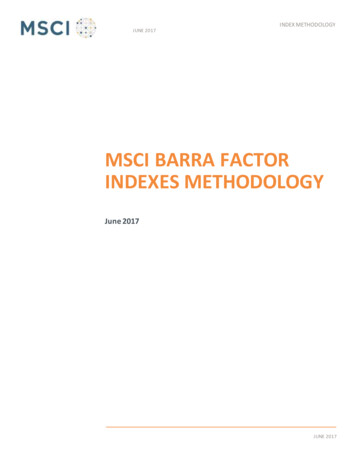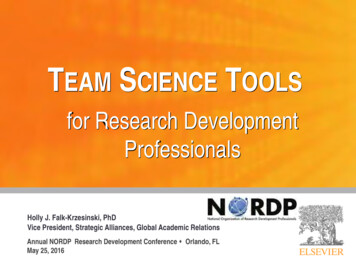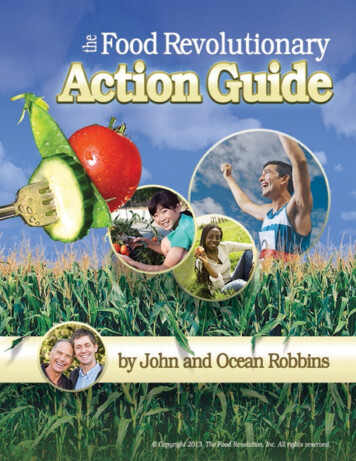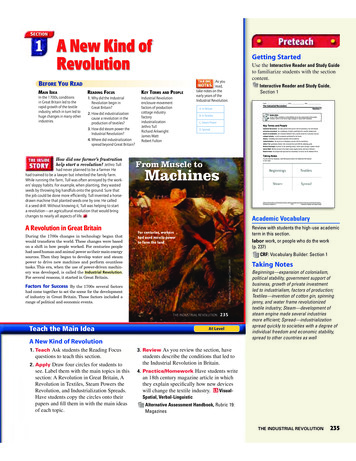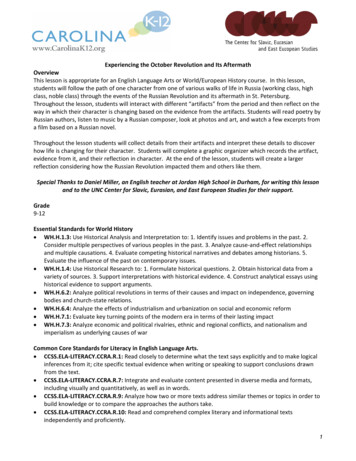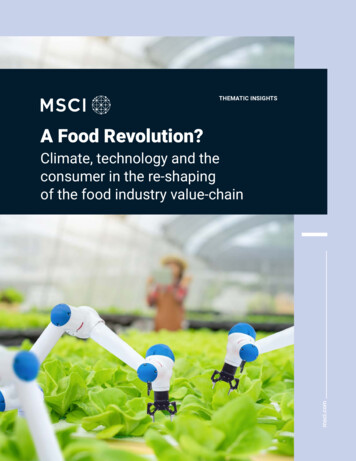
Transcription
THEMATIC INSIGHTSA Food Revolution?msci.comClimate, technology and theconsumer in the re-shapingof the food industry value-chainmsci.com 1
Contents04 Introduction06 What are the tailwinds?06 Population growth and the rise in animal-based food08 Agriculture and food production’s contribution to emissions09 A digital and more conscious consumer?10Technology transformation and food production11Sustainability in the food value chain15Conclusion2 msci.commsci.com 3
A Food Revolution?IntroductionFor many people, it’s easy to imagine the world has come along way from subsistence farming when food is characterisedas an experience to be shared on social media, rather than ananswer to a basic need (and one that needs to be satisfied ina sustainable way). So it should, perhaps, come as no surprisethat the global food and agribusiness industry is valued ataround USD 5 trillion and still projected to grow rapidly1.Historically, as we describe below, this growth has been drivenby population growth, urbanization and dietary changes thatare now harder to reconcile with urgent global initiatives onaddressing climate change risk, threats to biodiversity andpopulation health.2 In this Thematic Insight, we review thedevelopments that have emerged in recent years that suggestthe modes of human food production and patterns in theconsumption of food may change significantly.Alongside the sustainability and climate change challenge,consumer preferences and technological advancements(robotics, artificial intelligence, mobile technologies,biotechnology)3 are all part of a potential re-shaping of theentire food production and supply industry. We assess belowthe apparent tailwinds driving this megatrend and break downthe value chain into such areas as food innovation, verticalfarming, lab-grown/cultured meat, organic farming, use ofrobots, 3D food printing, mobile order and delivery sysems, etc.4 msci.comFinally, and perhaps as a counterweight to theexcitement of technological disruption, theexperience of the pandemic over the last yearhas focused the attention of investors on theimportance of supply chain control and as partof that, the role of zoonotic disease identification,monitoring and control.4 We consider these to bea critical component in the capture of a potentialFood Revolution megatrend.1Global agriculture’s many opportunities’, McKinsey & Co., July 20152“The food revolution: the future of food and the challenges we face”, UBSresearch, July 20193See the MSCI Thematic Insights series for more detail, ��Pandemics and food systems - towards a proactive food safety approachto disease prevention & management”, Aiyar, A. and Pingali, P. Food Sec. 12,749–756 (2020).msci.com 5
A Food Revolution?The Food and AgriculturalOrganization’s (FAO) estimate9that over 30% of the world’s fishstocks are currently being overfished is a reminder of how thistrend has impacted the planet’sfood resources and ecosystems.To compound matters, onlyabout half of global crop caloriesnourish people directly; theremainder is used as animal feedor as biofuels10. These data haveaccelerated interest in a shiftto less carbon-intensive proteinand meat alternatives, whichcould also use limited naturalresources more efficiently andwith less imapct on biodiversity.11What are thetailwinds?The food revolution currently being debatedis quite different from the so-called GreenRevolution5 of the 1960s, where the focus was onimproving crop yields and raising production withmuch less regard to future environmental costs.Instead, in the 21st century we may witnessa transformation not only in the way food isproduced but also in the way it is stored, deliveredand consumed. In this section, we assess thewide range of sometimes competing drivers (i.e.food security and environmental sustainability) ofthe touted food revolution megatrend.Moreover, as nations have become more prosperous, their diet hasbecome skewed towards foods like meat, poultry and dairy leadingto rising demand for animal feed in the form of corn and soybeans.Exhibit 1 shows that there has been a gradual but steady increase in theproportion of protein sourced from meat, dairy and seafood products vs.that from plant based products over the past 50 years.Source: Our World in Data; FAO80Also called the Third Agricultural Revolution, seehttps://en.wikipedia.org/wiki/Green Revolution6World Population Prospects 2019,United Nations, 20197“Smart cities: Defining the trend, describing thetransition”, MSCI Thematic Insights, June 20208“The food revolution: the future of food and thechallenges we face”, UBS research, July 2019; UN9“State of fisheries and aquaculture in the world”,FAO, November 201810 ‘Feeding the World’, National Geographic6011 FT Food Revolution online, lobal population has been projected to increase by another 2 billionpeople by the year 20506. This population growth is forecast to beassociated with rapid urbanization7 and hence further potential strain onthe planet’s stretched resources: food production accounts for 40% ofland use and 70% of freshwater consumption globally8.Exhibit 1:Shifting composition of human dietDaily per capita protein supplyPopulation growth and the rise in animal-based food5Proportion from animal-based foodProportion from plant-based food*estimate for the period 2015 to 20176 msci.commsci.com 7
A Food Revolution?Agriculture and food production’scontribution to emissionsThe global climate change emergencyis a second key driver of the potentialfood revolution. Estimates12 of foodproduction’s contribution to globalgreenhouse gas (GHG) emissions canreach as high as 25% (depending onthe inclusion of associated land use) – inparticular, emissions arise from methanereleased by cattle, nitrous oxide due to theincreased use of fertilisers and carbondioxide as a result of deforestation. Exhibit2 shows a breakdown of the emissionsfrom agriculture by various activities.Exhibit 2:Average agriculture emissions activity shares(CO2eq), 1990-2017Source: Food and Agricultural Organization6.80%10.10%39.60%11.90%15.10%To exemplify this stark fact, McKinsey andCompany calculated that cattle and dairycows emit enough GHGs to place themsecond in the league table of the world’ sbiggest emitters13. Moreover, many of theUN’s Sustainable Development Goals14(SDGs), namely, 11 (Sustainable Cities andCommunities), 13 (Climate Action), 14(Life Below Water) and 15 (Life on Land),focus on aspects of sustainable livingthat are drawing more and more attentionfrom insitutional investors. Hence, moresustainable farming practices to reduceemissions are critical but concerted actionis hampered by the fragmented nature ofglobal agriculture (and the involvement ofa quarter of the global population).A digital and more conscious consumer?A third element of the megatrend has been the evolution of amore digital and conscious consumer: from using smartphonesto check a product’s carbon footprint to the use of socialmedia alongside delivery and aggregator apps. Changes inconsumer preferences and behaviors are reshaping not justfood production but also how it is stored, delivered and eaten.There are greater demands for customisation and convenienceand many are keen to eliminate the drudgery of frequent mealplanning and supermarket trips. The experience of the pandemichas seen a further surge in the use of food delivery and homeshopping apps.15Innovations in additive manufacturing have introduced thepossibility of 3D-printed food while the rise of social media hasenabled instant marketing and customer reviews. The increaseduse of machine learning coupled with big data has enabledpersonalised meal planning at scale.Furthermore, the coronavirus pandemic in 2020 has led toincreased consumer focus on food safety practices and supplychains, particularly in the area of zoonotic disease (i.e. infectiousdisease transmitted from vertebrate animals to humans)mitigation16. Companies involved in this area focus on foodand animal safety solutions for genetic identification, detectionand prevention of pathogens. Other players include biotechcompanies that focus on the development of vaccines andtherapeutics for humans affected after zoonotic transmissionhas occurred.12 “The food revolution: the future of food and the challenges we face”, UBS research, July 2019;“Agriculture and Climate Change”, McKinsey & Co, April 2020; “The Contrbution of Agriculture toEmissions”, FAOSTAT, Feb 2020 states that in 2017, the percentage contribution of agriculture to worldCO2eq emissions from all human activities was 20%. This included a contribution of 11% from cropand livestock activities within the farm gate, and an additional 9% from related land use.16.50%Enteric FermentationManure left on Pasture13 “Agriculture and Climate Change”, McKinsey & Co, April 2020Rice CultivationManure Management14 ble-development-goals.htmlSynthetic FertilizersOther15 “Post-pandemic reflections: the digital economy - an assessment of emerging risks and opportunities”,MSCI Thematc Insights, June? 202016 20-01074-38 msci.commsci.com 9
A Food Revolution?Technology transformation and food productionTechnological advances in agri-genomics, data-driven decision making infarming and robotic farm assistance have also made a significant impacton the outlook for food production, storage and distribution. Roboticmilking machines17, robotic arms sensitive enough for fruit picking18, dronesfor 3D soil analysis19 and crop protection are already a reality on farms.Technological innvovation has also enabled adoption of vertical farmingtechniques which claim to offer the prospect of reducing water usage by95% and transportation costs by 90% compared to conventional methods20.Moreover, growing conditions (light, humidity, temperature etc.) in verticalfarms can be monitored and regulated remotely from a central locationusing connected devices. In a nod to this opportunity, the UK groceryretailer Ocado invested more than US 20 million in 2019 to grow leafyvegetables near its distribution centres through vertical farming21.Sustainability in thefood value chainThe global agribusiness and food industry is valuedat around USD 5 trillion22 of which the global meatindustry is estimated to be worth approximately USD1.4 trillion23. Barclays estimates that in 2020 the sizeof the plant-based meat segment was roughly 1%of this and project the size to reach 10% by 202924.Unilever’s recent announcement25 setting a target ofEUR 1 billion in annual sales of plant-based meat isconsistent with this.22 ‘Global agriculture’s many opportunities’, McKinsey & Co., July 201523 Beyond Meat’s 10K filing for 202024 ‘Carving up the alternative meat market’, Barclays, August 201917 ilking-systems-what-are-the-economics/18 mbledonOther segments of the value-chain alsoneed to be considered: smart farming, onlinefood delivery technology, seed treatmentand seed science. In Exhibit 3, we present acomprehensive view of the activities in theemerging agribusiness and food value chain.20 Infarm, a Berlin-based vertical farming startupExhibit 3:A less-linear and more consumer-focused food industry value chain21 dUSKCN1TB0UUSource: MSCI Research19 S0168169918301650Consumer PreferencesFarmers, OEMs, Special Chemicals cos.,Biotech and life sciences cos.Growing and Rearing10 msci.comHarvestingPackaging cos., Biotech & Pharma cos.,Supermarkets, Grocers, RestaurantsProcessing and PackagingSupermarkets, Restaurants, Aggregators,Delivery apps, Logistics cos.RetailingDistribution»Analysis of demand, supply and prices»»»Resource optimization (e.g. verticalfarming, precision farming andhydroponics)Natural flavours, fragrances andcoloursCold-chainlogistics»Plant-based meat alternatives»»Customised culinary experiencesStorage andWarehousing»Seed science (e.g. Agri-genomics)»Sustainable packaging»»Micronutrients»»IrrigationFood safety and zoonotic diseasemitigationThermalmonitoring»»3D soil maps»Waste reduction and managementWaste reductionand management»Corp protection and monitoring»»Breeding»Weather analysisFood andgrocery deliverytechnology»Satellite imagery»Robot assisted picking, harvesting andclearing»Robot assisted fishing and shearingConsumption»Instantreviews onsocial mediamsci.com 11
A Food Revolution?The importance of the food and grocerydelivery segment has been underscored bythe experience of the coronavirus pandemic.It has been critical to restaurants, restaurantsuppliers, supermarkets and take-outs whichhave been hardest hit by diners opting to eatin (or having no choice)26. This segment hasmany players: from mobile apps that aggregatedemand and orders to internet conglomeratesthat operate food delivery platforms. Exhibit4 shows the growth of online food deliveryusers, worldwide, since 2017. It has alsoattracted e-commerce giants such as Alibabaand Amazon (the latter acquired Whole Foodsand partnered with DHL to make frequentand flexible deliveries). Uber Eats and Lyft’s(pandemic-driven) ‘Essential Deliveries’27 alsooffer food and grocery delivery service. The roleof cold-chain storage and logistics is a naturalextension of food and grocery delivery technology.Although yet to see wide adoption, 3D printedfood is now practically feasible. Given theimportance of catering to consumer preferences,the potential to customise food to reflectnutritional needs could be key differentiator. Arecent report projected the global 3D printed foodmarket to grow at c.16% during 2020-2025.28Cultured or lab-grown meat is another exampleof what a potential food revolution may bring.Recently, Singapore became the first countryto approve the sale of cultured meat and a ‘testrestaurant’ in Israel claims to offer the world’s firstcultured meat chicken burger.29Exhibit 4:Growth of food delivery users, worldwideSource: Statistia, September 2020 (Estimates adjusted for impact of Covid-19)1000Million users800600400200201720182019Platform to consumer2020 Est2021Est2022EstRestaurant to consumer2023Est2024EstReduction of food waste isincreasingly being recognised asa critical component of the foodvalue chain. McKinsey & Companyestimate that approximately 30% ofcrop is lost during the harvestingphase in emerging economieswhile most food waste in advancedeconomies occurs at restaurantsand consumers’ homes30. In 2018BCG estimated31 that food worthUSD 1.2 trillion goes to wasteglobally and forecasted that thiswould grow to USD 1.5 trillion by2030. The environmental impactof food waste is also staggering.According to Project Drawdown,the food we waste is responsiblefor roughly 8 percent of globalemissions32. Moreover, food wastethat is dumped in its orignal plasticpackaging makes its way into the soilor the oceans as microplastics. Aresearch team33 found upto 440,000pieces of microplastic in a single tonof compost from domestic organicwaste. Companies have respondedto this alarming trend of food waste.Apps enabling peer-to-peer foodsharing, alerting consumers whenfood in their refrigerators is aboutto go past the best by date, andapps that facilitate the creation ofsecondary markets to sell food thatwould otherwise be wasted, haveall appeared.12 msci.com25 t-basedfoods?utm term cf3be567091c7c89b727e3f7f77c966a&utmcampaign BusinessToday&utm source esp&utmmedium Email&CMP bustoday email26 ‘Grocery delivery apps see record downlaods amid coronavirusoutbreak’, TechCrunch, March 202027 ooddelivery-drivers-service-coronavirus-pandemic28 '3D Food Printing', June 202029 ll-labgrown-chicken-burger-restaurant-israel30 ‘Pursuing the global oppportunity in food and agribusiness,McKinsey & Co., July 201531 ‘Tackling the global 1.6 billion ton food loss and waste crisis’,BCG Henderson Institute, August 201832 ste33 60msci.com 13
A Food Revolution?ConclusionWe have provided a comprehensiveoverview of the key activities in thechanging food and agriculture valuechain. We have illustrated the potentiallyprofound impact of the three keydrivers, technology, climate change andchanging consumer preferences on theglobal agriculture and food industry. Itis the convergence of transformationalchanges stemming from these driversthat seems the most intriguing prospectfor a USD 5 trillion global agriculture andfood market.14 msci.commsci.com 15
Contact tonChicagoMonterreyNew YorkSan FranciscoSão PauloToronto1 888 588 4567 * 1 404 551 3212 1 617 532 0920 1 312 675 0545 52 81 1253 4020 1 212 804 3901 1 415 836 8800 55 11 3706 1360 1 416 628 1007EUROPE, MIDDLE EAST & AFRICAASIA PACIFICCape TownFrankfurtGenevaLondonMilanParisChina NorthChina SouthHong KongMumbaiSeoulSingaporeSydneyTaipeiThailandTokyo 27 21 673 0100 49 69 133 859 00 41 22 817 9777 44 20 7618 2222 39 02 5849 04150800 91 59 17 *10800 852 1032 *10800 152 1032 * 852 2844 9333 91 22 6784 916000798 8521 3392 *800 852 3749 * 61 2 9033 9333008 0112 7513 *0018 0015 6207 7181 * 81 3 5290 1555About MSCIMSCI is a leading provider of critical decision support toolsand services for the global investment community. Withover 50 years of expertise in research, data and technology,we power better investment decisions by enabling clientsto understand and analyze key drivers of risk and returnand confidently build more effective portfolios. We createindustry-leading research-enhanced solutions that clientsuse to gain insight into and improve transparency across theinvestment process.To learn more, please visit www.msci.comThe information contained herein (the “Information”) may not be reproduced or disseminated in whole or in part without prior written permission from MSCI. The Information may not be used to verify orcorrect other data, to create indexes, risk models, or analytics, or in connection with issuing, offering, sponsoring, managing or marketing any securities, portfolios, financial products or other investmentvehicles. Historical data and analysis should not be taken as an indication or guarantee of any future performance, analysis, forecast or prediction. None of the Information or MSCI index or other productor service constitutes an offer to buy or sell, or a promotion or recommendation of, any security, financial instrument or product or trading strategy. Further, none of the Information or any MSCI indexis intended to constitute investment advice or a recommendation to make (or refrain from making) any kind of investment decision and may not be relied on as such. The Information is provided “as is”and the user of the Information assumes the entire risk of any use it may make or permit to be made of the Information. NONE OF MSCI INC. OR ANY OF ITS SUBSIDIARIES OR ITS OR THEIR DIRECT ORINDIRECT SUPPLIERS OR ANY THIRD PARTY INVOLVED IN THE MAKING OR COMPILING OF THE INFORMATION (EACH, AN “MSCI PARTY”) MAKES ANY WARRANTIES OR REPRESENTATIONS AND, TOTHE MAXIMUM EXTENT PERMITTED BY LAW, EACH MSCI PARTY HEREBY EXPRESSLY DISCLAIMS ALL IMPLIED WARRANTIES, INCLUDING WARRANTIES OF MERCHANTABILITY AND FITNESS FORA PARTICULAR PURPOSE. WITHOUT LIMITING ANY OF THE FOREGOING AND TO THE MAXIMUM EXTENT PERMITTED BY LAW, IN NO EVENT SHALL ANY OF THE MSCI PARTIES HAVE ANY LIABILITYREGARDING ANY OF THE INFORMATION FOR ANY DIRECT, INDIRECT, SPECIAL, PUNITIVE, CONSEQUENTIAL (INCLUDING LOST PROFITS) OR ANY OTHER DAMAGES EVEN IF NOTIFIED OF THEPOSSIBILITY OF SUCH DAMAGES. The foregoing shall not exclude or limit any liability that may not by applicable law be excluded or limited.The process for submitting a formal index complaint can be found on the index regulation page of MSCI’s website at: https://www.msci.com/index-regulation. 2020 MSCI Inc. All rights reserved CBR122016 msci.com
2 “The food revolution: the future of food and the challenges we face”, UBS research, July 2019 . and many are keen to eliminate the drudgery of frequent meal planning and supermarket trips. The experience of the pandemic has
